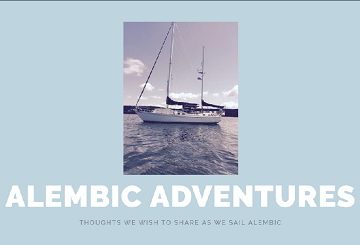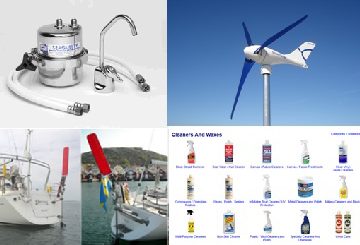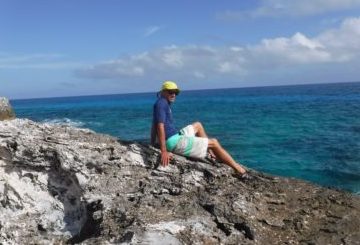Roatan for Easter

This was our path up from a dinghy dock at a Yacht Club. The caretaker was in charge as the owner sorts out his money laundering charges!

While the owner is away, sorting out his legal troubles, Hayman likes to hang out at the Yacht Club to help cruisers find what they need.
Roatan was one island we were so looking forward to visiting. Guanaja to the east and Utila to the west are much smaller islands with less people, and less to do, so we thought that Roatan would be our paradise in Honduras. Unfortunately, we arrived at a challenging time and didn’t have the opportunity to fully explore or appreciate this gem of the Caribbean. Challenges revolved around wild weather, a lack of rally cohesiveness, and the need to move on to Belize to pick up guests.
Back in Maine, we met Elvert, a young man who grew up on Roatan and now works in New England. He graciously informed us about places to anchor, scuba dive, eat, fix boats, and find transportation. We shared his emails with all of the rally members and we tried to coordinate dive trips and excursions with Elvert’s many relatives and acquaintances.
Winds howled every night and sometimes throughout the day as well, which made scuba diving and other adventures less appealing, and also caused us to be nervous about leaving Alembic at anchor. Several boats dragged their anchors, one causing a collision with their neighbor.
Twenty-six rally boats were becoming scattered about many islands at this point, as weather, guest arrivals, and boat repairs were creating different needs and interests. We ranged from Providencia, Guanaja, Utila, Guatemala, and Belize, and three boats have already left us to transit the Panama Canal for the Pacific.
Bill and I had begun to feel pressed for time, as we have guests arriving in Belize next week, so we had to sail away before we could follow through on our hopes for Roatan.
While weather and scattered rally boats limited our activities, we certainly enjoyed what we could see and do. To start off, our sail from Guanaja to Roatan was glorious. James, a British gentleman who has lived on these two islands for a few years, was flying home to the UK and needed a lift to Roatan. He had never sailed before, and was lucky enough to transit on a perfect weather window; the calm before the storm!

Looking from our anchor spot to the marina where some rally members tied up and filled it to capacity.
Anchoring in French Cay Harbor was like being in Grand Central Station! Mini ferry boats zoomed back and forth every ten minutes, carrying people and horses!! to Fantasy Island. During our five day stay, three boats were towed into the anchorage in distress as they lost steering or engines in the waves just outside the entrance reefs. One morning we tried to assist a sailboat on the reef, but even with the four dinghies, we could not begin to help. The seas were huge and our dinghies were almost flipping just trying to get near them. Luckily, their anchor held until a tow boat came to haul them in.
Nature abounds on this island near French Cay Harbor. There is an Iguana Farm where Iguanas are free to roam and have thrived on the visitors’ offerings of fruit and vegetables.
Bill and I brought our compost bucket and shared papaya, banana, carrot, and pumpkin peels. Friendly monkeys jump around in the trees just above your head at the beach area. They love to bang on the outdoor shower nozzle, telling you to turn it on, so they can drink or play in the clear water. Interesting rodents, which look like huge shiny rats with no tails, wander about everywhere, hoping you’ll toss them food. And bird life is prolific; I wish I knew the names of half of them.Easter was a special day on Roatan. Our best laid plans to attend a service didn’t work out as we had intended. Getting to shore by dinghy in the wild winds, redressing on the dock into dry clothes, climbing up the hill, and sitting down in the church, all went smoothly with a lot of laughs with fellow cruisers. Then we found out that the 9 o’clock service was a children’s bible study, and the service wouldn’t start until 10:30. We had a mini bus to catch at 11 with the rally members to spend the rest of the day celebrating at the West End. Bummer; the service didn’t fit into our plans. “No worries,” said Claire and James, “we will have our own service aboard Ocean Rainbow!” And that we did. Prayers for all of our loved ones, bible readings, and plenty of hymns, filled my heart with Easter love. Claire is excellent with the guitar and James, being a retired British General, is perfect for all things formal.
When the winds calmed enough for us to leave Alembic for a longer period, we rented scooters with friends and drove around the island. We found such a variety of sights.

A well armed guard, getting ready to protect the swarm of toursists to come off the cruise ship. Crime is way down, partly due to the guards
Cay and George will be arriving in a week, so we need to take advantage of the weather window to sail on to Utila, then Belize.





















































































































































